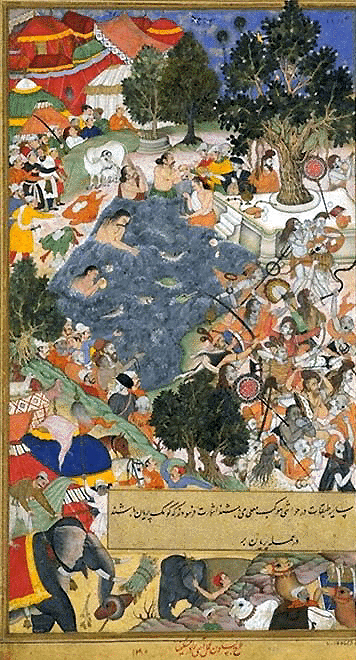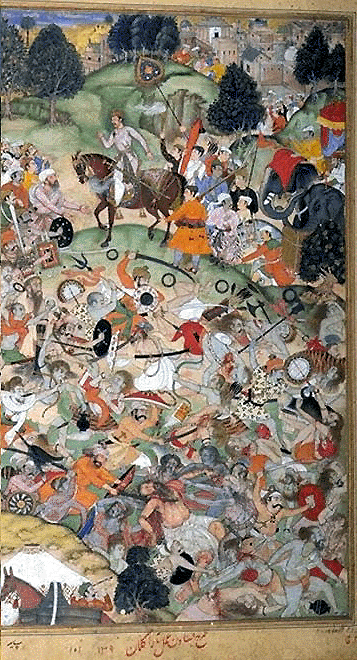
|
|
|
|
BY: SUN STAFF

Mughals Slay the Sannyasis at Thanesar Jun 09, 2010 — CANADA (SUN) — A serial presentation of the Mughal effect on Vaisnava society. As we have attempted to illustrate over the last few segments of this series, the Mughal emperor Akbar is often described as having been the most benign of all the early Mughal rulers. Some historians – particularly those who are sympathetic with Islam, suggest that Akbar demonstrated fairness and even compassion to the Hindus he subjugated across northern and central India. But as we read the historical accounts of massacres like that at Chittor and the battle of Ranthambhor, a different picture emerges.
In fact, Akbar continued on with the policies of his predecessors, Babur and Humayun, destroying Hindu towns, villages and temples in many places. Akbar's personal attendant, Bayazid Biyat, recorded the fact that Akbar gave two villages for the upkeep of a mosque and madrasa (school), which were established following his destruction of a Hindu temple. A great many temples were destroyed, including a number of rich Vaisnava temples having gold deities, in the Doab region, between the Ganga and Yamuna. The historian Abd al-Qadir Badauni recorded the fact that during Akbar's reign at Nagarkot, near Kangra, some 200 cows were slaughtered, numerous Hindus killed, and the local temple demolished. "On the 1st Rajab 990 [AD 1582] Akbar's forces encamped by a field of maize near Nagarkot. The fortress (hissar) of Bhim, which has an idol temple of Mahamai, and in which none but her servants dwelt, was taken by the valour of the assailants at the first assault. A party of Rajpus, who had resolved to die, fought most desperately till they were all cut down. A number of Brahmans who for many years had served the temple, never gave one thought to flight, and were killed. Nearly 200 black cows belonging to Hindus had, during the struggle, crowded together for shelter in the temple. Some savage Turks, while the arrows and bullets were falling like rain, killed those cows. They then took off their boots and filled them with the blood and cast it upon the roof and walls of the temple." An equally terrible example of Akbar's brutality is found in the story of his activities at Thaneswar (Haryana). About a year before the massacre of nearly 40,000 civilians and Rajputs at Chittor, Akbar and his men went to Thaneswar. It happened that at that time, a congregation of sadhus had gathered at a holy tank in the village. Among all the ascetics gathered to take holy bath, a fight broke out between the two predominant groups over who should get to bathe first, and at the best spot.

Mughals Slay the Sannyasis at Thanesar The fight between the sadhus became violent, and the Mughals gathered to watch. Akbar himself came, and ordered his soldiers to intervene on the side of one of the groups. The logic apparently was that as long as one group of infidels killed members of the other group, the total number of infidels would be reduced, thereby making the presence of Islam even greater. Akbar's soldiers stepped into the middle of the unfortunate sadhus fighting at the tank that day, and began cutting them down with swords, axes, and arrows. Surprisingly enough, the events at Thaneswar were recorded by four different historians from Akbar's court: Nizamuddin Ahmad, Badauni, Abu'l Fazl, and another anonymous writer. The accounts provided by the latter two were embellished with lavish illustrations of the sannyasis, dressed in various types of attire, engaged in combat with one another and with the Mughals. While there are some discrepancies between the four accounts, for the most part the writers were in agreement about the main facts: that Akbar's entourage had encountered two bands of Hindu ascetics at Thaneswar; the location of the event was a large body or 'tank' of water, to which people from throughout north India flocked to take holy bath and make offerings; each group claimed to have the right to occupy the most auspicious location at the shrine that day; each group of sadhus was armed; after some discussion, Akbar granted permission for the ascetics to take up an armed contest to settle the issue; as the contest escalated, Akbar ordered some of his soldiers to enter the fight, assisting the smaller group; and after considerable violence and bloodshed, the smaller group of sadhus prevailed. There is a much later version of the event at Thaneswar, dated circa 1925. This version is thought to be a written record of the story as it was passed down by oral tradition amongst the sannyasis. Their story is told very differently, as will be seen in tomorrow's segment.
| |